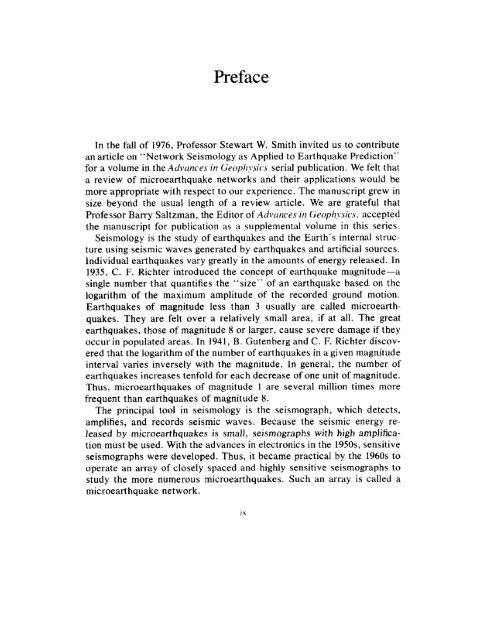principles and applications of microearthquake networks
principles and applications of microearthquake networks
principles and applications of microearthquake networks
You also want an ePaper? Increase the reach of your titles
YUMPU automatically turns print PDFs into web optimized ePapers that Google loves.
Preface<br />
In the fall <strong>of</strong> 1976, Pr<strong>of</strong>essor Stewart W. Smith invited us to contribute<br />
an article on "Network Seismology as Applied to Earthquake Prediction"<br />
for a volume in the Advcinces in Geoph!,sic:\ serial publication. We felt that<br />
a review <strong>of</strong> <strong>microearthquake</strong> <strong>networks</strong> <strong>and</strong> their <strong>applications</strong> would be<br />
more appropriate with respect to our experience. The manuscript grew in<br />
size beyond the usual length <strong>of</strong> a review article. We are grateful that<br />
Pr<strong>of</strong>essor Barry Saltzman, the Editor <strong>of</strong> Adviirrces in Geophy.\ics, accepted<br />
the manuscript for publication as a supplemental volume in this series.<br />
Seismology is the study <strong>of</strong> earthquakes <strong>and</strong> the Earth's internal structure<br />
using seismic waves generated by earthquakes <strong>and</strong> artificial sources.<br />
Individual earthquakes vary greatly in the amounts <strong>of</strong> energy released. In<br />
1935, C. F. Richter introduced the concept <strong>of</strong> earthquake magnitude-a<br />
single number that quantifies the "size" <strong>of</strong> an earthquake based on the<br />
logarithm <strong>of</strong> the maximum amplitude <strong>of</strong> the recorded ground motion.<br />
Earthquakes <strong>of</strong> magnitude less than 3 usually are called <strong>microearthquake</strong>s.<br />
They are felt over a relatively small area, if at all. The great<br />
earthquakes, those <strong>of</strong> magnitude 8 or larger, cause severe damage if they<br />
occur in populated areas. In 1941, B. Gutenberg <strong>and</strong> C. F. Richter discovered<br />
that the logarithm <strong>of</strong> the number <strong>of</strong> earthquakes in a given magnitude<br />
interval varies inversely with the magnitude. In general, the number <strong>of</strong><br />
earthquakes increases tenfold for each decrease <strong>of</strong> one unit <strong>of</strong> magnitude.<br />
Thus, <strong>microearthquake</strong>s <strong>of</strong> magnitude 1 are several million times more<br />
frequent than earthquakes <strong>of</strong> magnitude 8.<br />
The principal tool in seismology is the seismograph, which detects,<br />
amplifies, <strong>and</strong> records seismic waves. Because the seismic energy released<br />
by <strong>microearthquake</strong>s is small, seismographs with high amplification<br />
must be used. With the advances in electronics in the 1950s, sensitive<br />
seismographs were developed. Thus, it became practical by the 1960s to<br />
operate an array <strong>of</strong> closely spaced <strong>and</strong> highly sensitive seismographs to<br />
study the more numerous <strong>microearthquake</strong>s. Such an array is called a<br />
<strong>microearthquake</strong> network.<br />
1X






